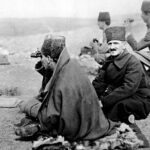The Russian invasion of Ukraine, in its full-scale war for the third year with level overall years of conflict, is reaching a critical moment where both Kyiv’s and Moscow’s will to fight comes down to attrition. Under the second Trump Administration, peace talks and proposals of frozen lines have taken place with NATO members, Ukrainian President Volodymyr Zelenksy, and Russian President and longtime autocrat Vladimir Putin.
The United Kingdom and other continental heavyweights such as France and Germany have discussed a major European peacekeeping contingent if the Russian invasion of Ukraine mirrors the Korean War conclusion with frozen lines. Nevertheless, challenges will remain regarding the deployment of a British-led contingent.
Substantial safeguards will be necessary for deployed European forces in Ukraine, who will have different rules of engagement compared to those in prior combat deployments in Mali, Iraq, and Afghanistan. Furthermore, questions will remain regarding the adequate allocation of rotational force among each contributing country, the stability of Ukraine, and the support from the United States for the peacekeeping proposals.
Potential Peacekeeping Operations in Ukraine
On March 15, 2025, during a high-level virtual meeting in London, British Prime Minister Keir Starmer proposed plans to potentially send 10,000 peacekeeping troops to Ukraine, which would be led by British forces. The 10,000 is the official estimate of the overall number of European soldiers proposed to be sent, with the majority being British and French, as Prime Minister Keir Starmer stated to The Sunday Times.
Several days later, France also committed to the proposal as French President Emmanuel Macron had previously proposed sending troops to Ukraine as Russia’s wartime capabilities continue to grow. Other countries that could potentially join the ‘coalition of the willing’ include Finland, Sweden, Turkey, Estonia, Lithuania, and others.
Deployments in Ukraine would have to be based in and around the contact lines, which are currently unknown. Despite the substantial casualties, the Russian military has advanced—albeit through increments—particularly in the Donetsk oblast.
In case of further Russian aggression after a ceasefire, putting Western troops on potential contact points could not only deter Russian military action but free up Ukrainian forces tied down in former combat zones such as Northern Ukraine.
If the lines were to be frozen under diplomatic pressure with both exhausted Ukrainian and Russian forces, the British-led contingent could be deployed in key sectors. Sumy, Kharkiv, Luhansk, Donetsk, Zaporizhzhia, the left bank of Kherson, and the border with Belarus would need to be manned to deter further Russian aggression with command-and-control centers in Kyiv and Odesa.
Hurdles Over the Deployment and Rotational Abilities of European Forces
The implementation of a peacekeeping contingent will need to be considered several factors, including the rotational capabilities of each participating nation, the number of troops allocated by each country, and the potential political ramifications at home.
The United Kingdom and France can provide sizable contingents of troops that would not affect mission readiness for other areas of operations. However, other European countries may struggle to rotate their own. Furthermore, questions remain over the length of the mission, such as how long the commitment of British and allied forces will be and whether it will fall under NATO command or a task force solely allocated for Ukraine.
Each deployment would be about 3-6 months, and other countries would need to step up. Finland, despite having the continent’s largest reserve army, has a small full-time defense force.
Other countries that are staunch supporters of Ukraine, such as Denmark, Norway, Sweden, Latvia, Lithuania, and Estonia, also have small militaries and would need to balance out the small contingents each country would send on a rotational basis. With various countries in Europe facing an aging population or recruitment shortfalls, European defense ministers will consider the need to protect career-long, experienced troops from deployment. They may utilize them in an advisory and assistant role only.
Lastly, Europe faces a surge in populist parties that are sympathetic or take direct funding from the Kremlin. The UK and other countries face strong resistance from populist movements. As a result, any deployment into Ukraine could be detrimental to each country’s next elections. While the current heads of state and their parliaments could approve future deployments, a potential shift in future elections—particularly by pro-Russian or isolationist parties — could immediately reverse the decision.
Factors to Consider
Outside of troop rotations, political pushback, and the allocation of units per country, major questions remain about whether the United States will support the mission, the rules of engagement, and the willingness of European countries to take control of their security apparatus.
On June 4, 2025, Bloomberg reported that the United States would not allocate air defense assets to the forces of the European continent. Without security guarantees, even in the defensive posture by the United States, which has some of the world’s top air defense systems, the potential UK-led mission may come into jeopardy.
Suppose European troops are given the green light and stationed throughout key sectors of Ukraine. In that case, their Rules of Engagement (ROEs) will come under exploitation by Russia, which has a history of pushing the escalation ladder, as seen in the Battle of Khasham.
For example, what are the rules of engagement (ROEs) and protocols if British and other peacekeeping troops come under direct fire from Russian forces? Currently, European countries have no comprehensive plans for directly confronting Russia. With France and the UK assisting in advisory roles away from the frontlines of Ukraine throughout European training centers, the Kremlin could view the powerhouse nations of Europe as direct participants in the war and seek to dissuade their parliaments from supporting the mission.
Given the lack of clear American support and political pushback at home, the Kremlin could potentially exploit the contingent through confrontation or hybrid warfare tactics.
The Russian Federation has previously rejected ideas for Western troops to be deployed in Ukraine, and because of this, hostilities will certainly be tested along various sectors. Due to the need for clear guidelines and rules of engagement (ROEs), the British-led contingent will require a clear and thorough doctrine for protecting its forces. Field officers will need to enact deterrence measures and respond to sporadic and direct fire with superior firepower to reassure Moscow that any provocations will come with serious repercussions without pushing the escalation ladder toward renewed full-scale war.
Lastly, the coalition of the willing needs to be fully committed and undeterred by Russia’s potential provocations, which could escalate the situation. To become fully autonomous and less dependent on the United States, the British-led peacekeeping contingent in Ukraine will need the experience to initiate the process of bolstering European security.
Overall, the pros outweigh the cons regarding a British-led peacekeeping contingent; however, the ‘peacekeeping’ aspect can turn hot as both Europe’s and Russia’s thresholds for escalation will be tested. As the United States focuses more on Asia and Russia’s imperial ambitions extend beyond Ukraine, European countries need to become more autonomous and tactful in confronting the greatest threat on the continent.

Julian McBride
Julian McBride is a former US Marine, forensic anthropologist, and independent journalist born in New York. His bylines can be found in the National Security Journal, Byline Times, 19FortyFive, Heritage Daily, The Defense Post, Journal of Forensic Psychology, Modern Diplomacy, Small Wars Journal, Modern Warfare Institute, Manara Mag, The Strategist, NKInsider, and UK Defence Journal.


